Mie Goreng (also spelled Mi Goreng or Mee Goreng) is an Indonesian stir-fried noodle dish that also has variations in Malaysia and other parts of Southeast Asia. The stir-fry sauce features a unique balance of savory, sweet, and spicy.
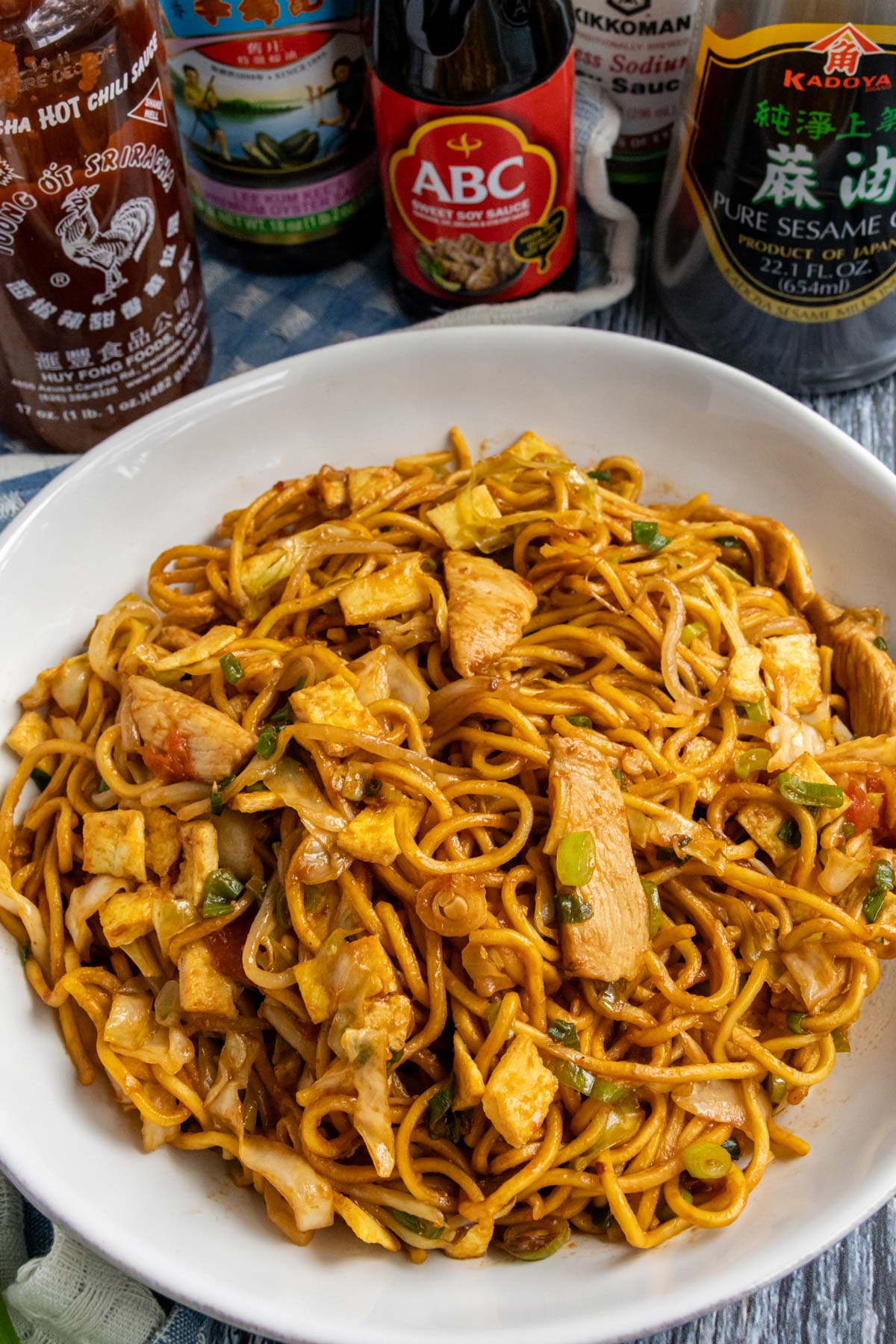
Mie Goreng (also written as Mi Goreng or Mee Goreng) is a stir-fried noodle dish popular in Southeast Asia. The words “mie goreng” literally translate to “fried noodles.”
In Indonesia they’re called mie goreng or mi goreng and in Malaysia they’re mee goreng or mi goreng, with slight variations in ingredients and preparation from region to region. For example, in Malaysia you’ll often find a bit of curry powder added!
These stir-fried noodles are a popular street food that were influenced by Chinese immigrants to Indonesia, and are inspired by Chinese chow mein noodles. Despite their Chinese origins, these noodles are definitely Indonesian owing to the use of sweet soy sauce and the preference of proteins such as chicken or shrimp rather than pork, which is more common in Chinese cooking.
In addition to savory, mie goreng also features sweet and spicy flavors in the sauce. The sweet comes from a combination of kecap manis (Indonesian sweet soy sauce) and ketchup (yes, ketchup) while the spicy comes from either sambal oelek, sriracha or even fresh chiles. This unique flavor profile is a big part of what makes mie goreng so different from other stir-fried noodle dishes.
Ingredient notes
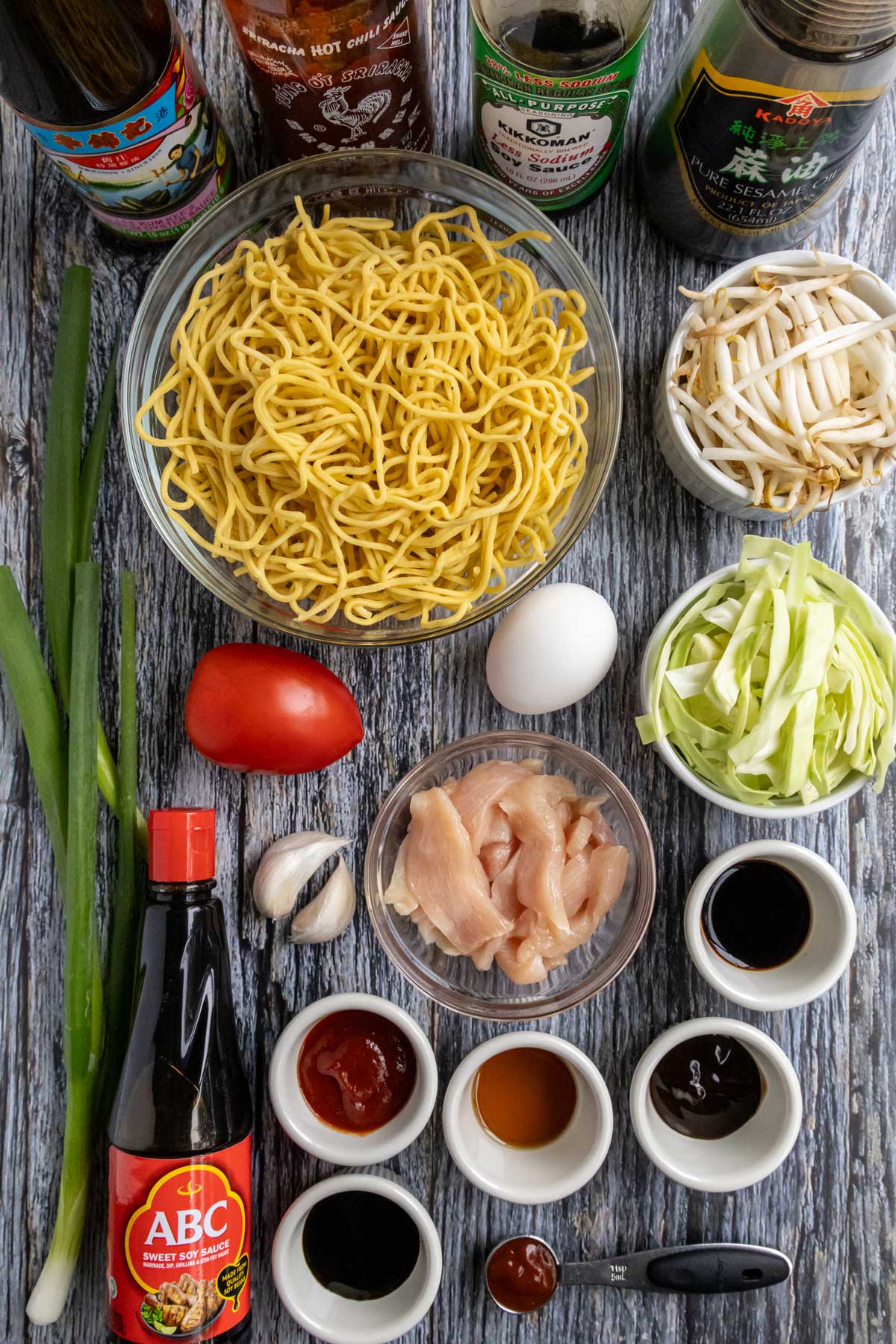
- Noodles: Yellow Chinese egg noodles (such as chow mein noodles) are perfect for making mie goreng. You can use dried, fresh, or par-cooked Chinese egg noodles. Use about 10 ounces fresh/par-cooked or 6 ounces dried. The par-cooked chow mein noodles I used are from Twin Marquis and can be added right to the stir-fry without boiling first. Always follow package directions to determine how to prep the noodles before stir-frying them, as methods will vary depending on the noodle. You could also use lo mein noodles (which are a bit thicker than chow mein noodles) or instant ramen noodles (about 3 packages of the noodles only without the seasoning packet). In a pinch, you could use spaghetti though it’s not really the best or most authentic substitute.
- Protein: Chicken and shrimp are both excellent options here. You could use either thinly sliced raw chicken breast or peeled and deveined shrimp (or a combination of both). You won’t need much, since the star of the show is the noodles themselves.
- Kecap Manis: Mie goreng isn’t mie goreng without kecap manis, or Indonesian sweet soy sauce. If you can’t find kecap manis to purchase it, you can make a variation yourself for this recipe. To do so combine three parts honey, maple syrup, or brown sugar with one part soy sauce.
- Soy Sauce: Use light (regular) soy sauce. My personal preference is the low-sodium variety.
- Sambal Oelek or Sriracha: Mie goreng typically has a decent kick due to the addition of chili sauce and/or sliced fresh chiles. Sriracha and sambal oelek are both great options you can easily add to your stir-fry sauce to add a bit of heat. Add more if you want it spicier.
- Cabbage: Sliced cabbage is ubiquitous in these famous stir-fried noodles. If you’d like you can swap them out for another member of the cabbage family, bok choy. Either would be delicious here. I use green cabbage in these photos but Napa cabbage would also be a great choice.
- Tomatoes: Although a lot of recipes don’t feature fresh tomatoes, my favorite mie goreng from a local restaurant includes tomatoes. I love the freshness and juiciness that the tomatoes contribute to this dish. If you add them midway through cooking they will soften and get juicy. Alternatively, add them closer to the end to retain their structure.
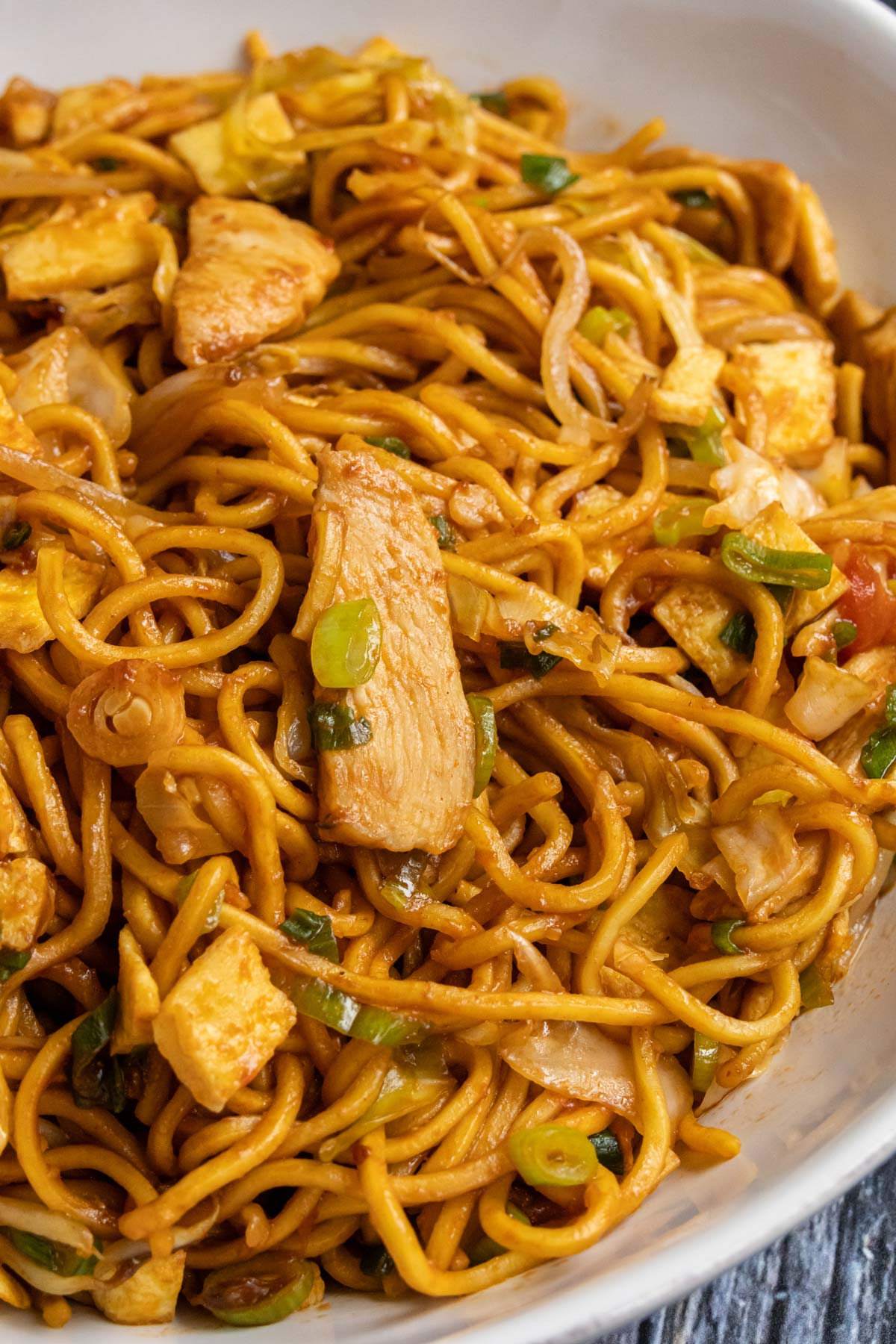
How to make it
Whisk together the sauce ingredients in a bowl and set aside.
If using dry noodles or fresh noodles that require cooking, boil the noodles according to package directions, drain, rinse with cold water, and set aside. If using fresh/par-cooked noodles (check the packaging for cooking instructions), you don’t need to boil them in advance.
While the noodles are boiling, heat half the oil in a wok or large (preferably nonstick) skillet or pan over medium-high heat. Add the beaten egg, tilting the pan slightly so it spreads out evenly. Cook the omelet for about 1 to 2 minutes and then flip it over and finish cooking the other side for a few more seconds until it’s cooked through (it’s ok if it breaks up, you’re going to chop it anyway).

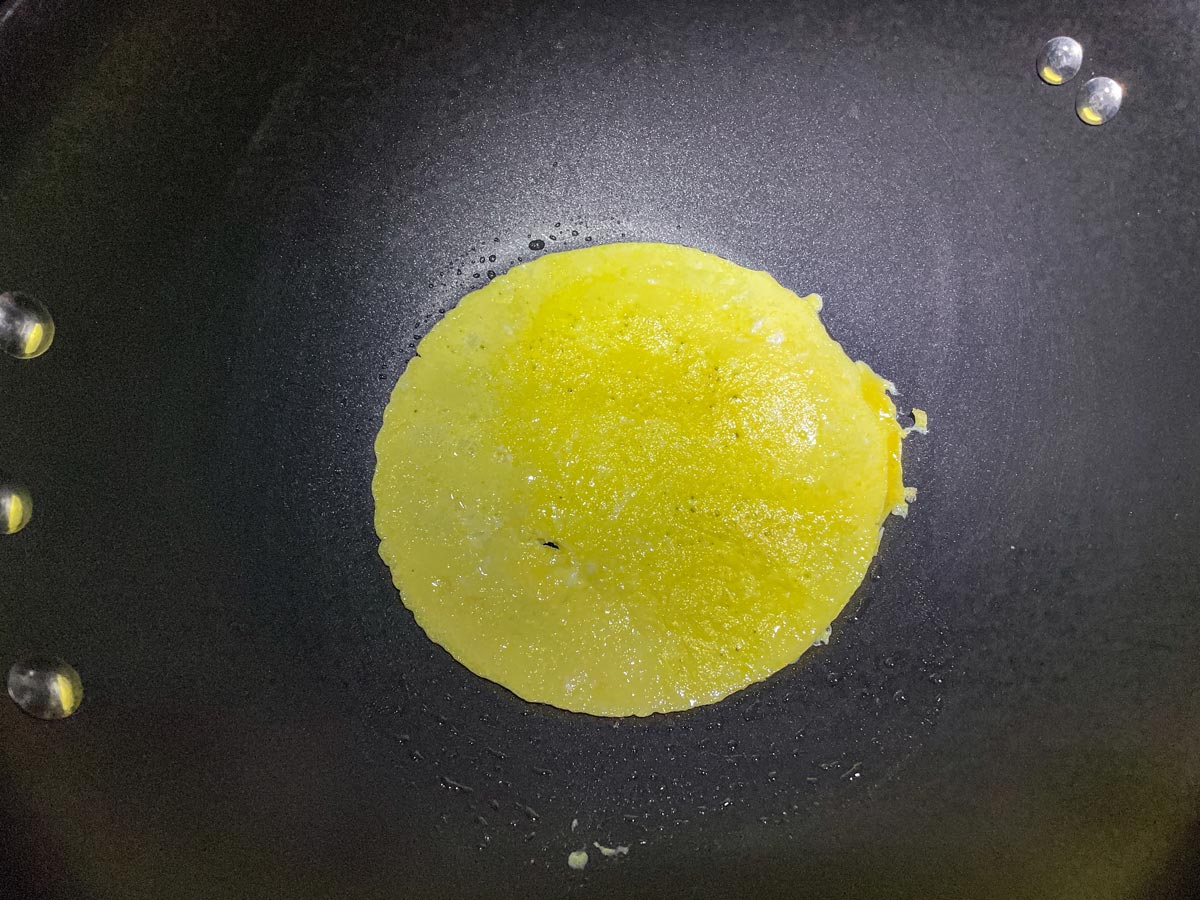
Remove from the pan to a cutting board and cut it into strips or dice it up.

Add the remaining oil to the pan over high heat and add the chicken or shrimp, stir-frying for 1 to 2 minutes until mostly cooked through.
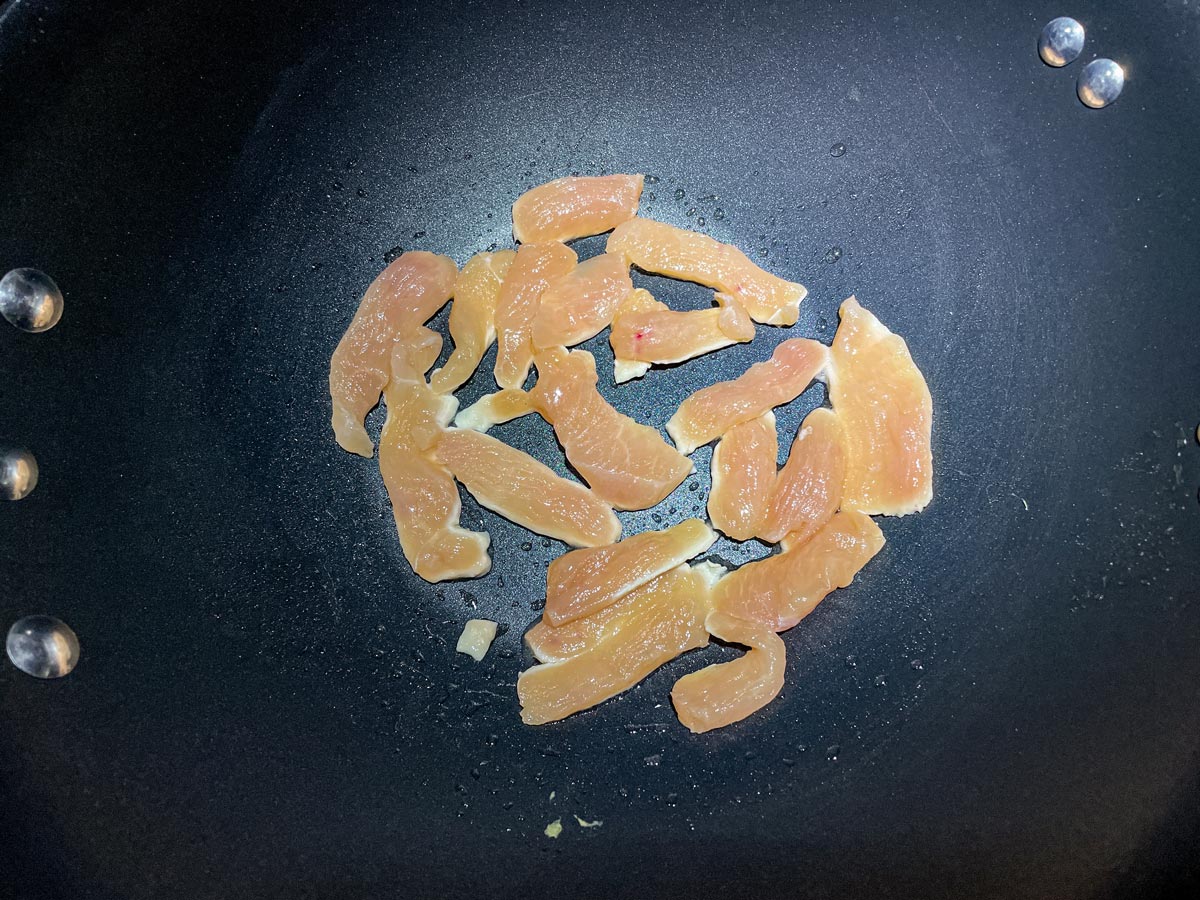
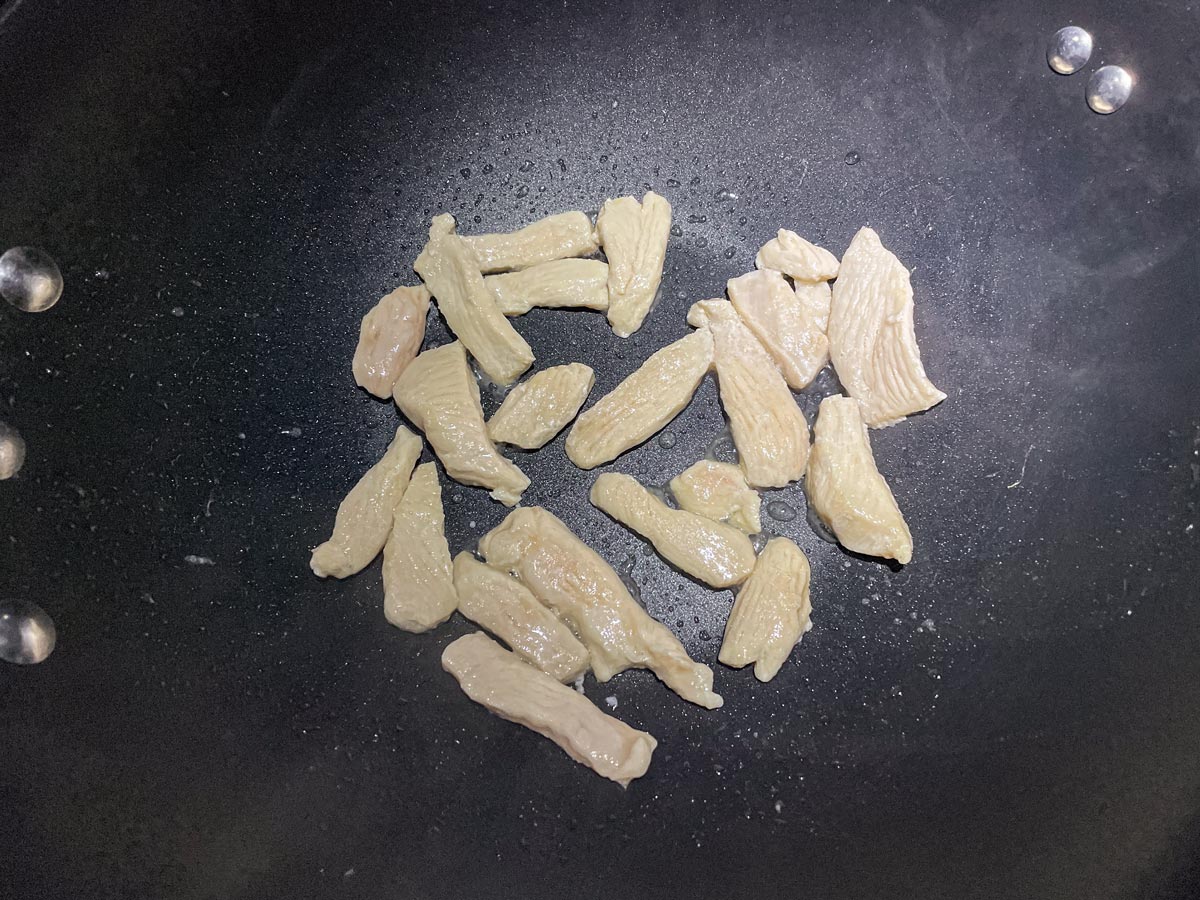
Add the garlic, and stir-fry for another 30 to 60 seconds or so until fragrant. Toss in the cabbage and bean sprouts and cook for about 1 minute until they begin to wilt.

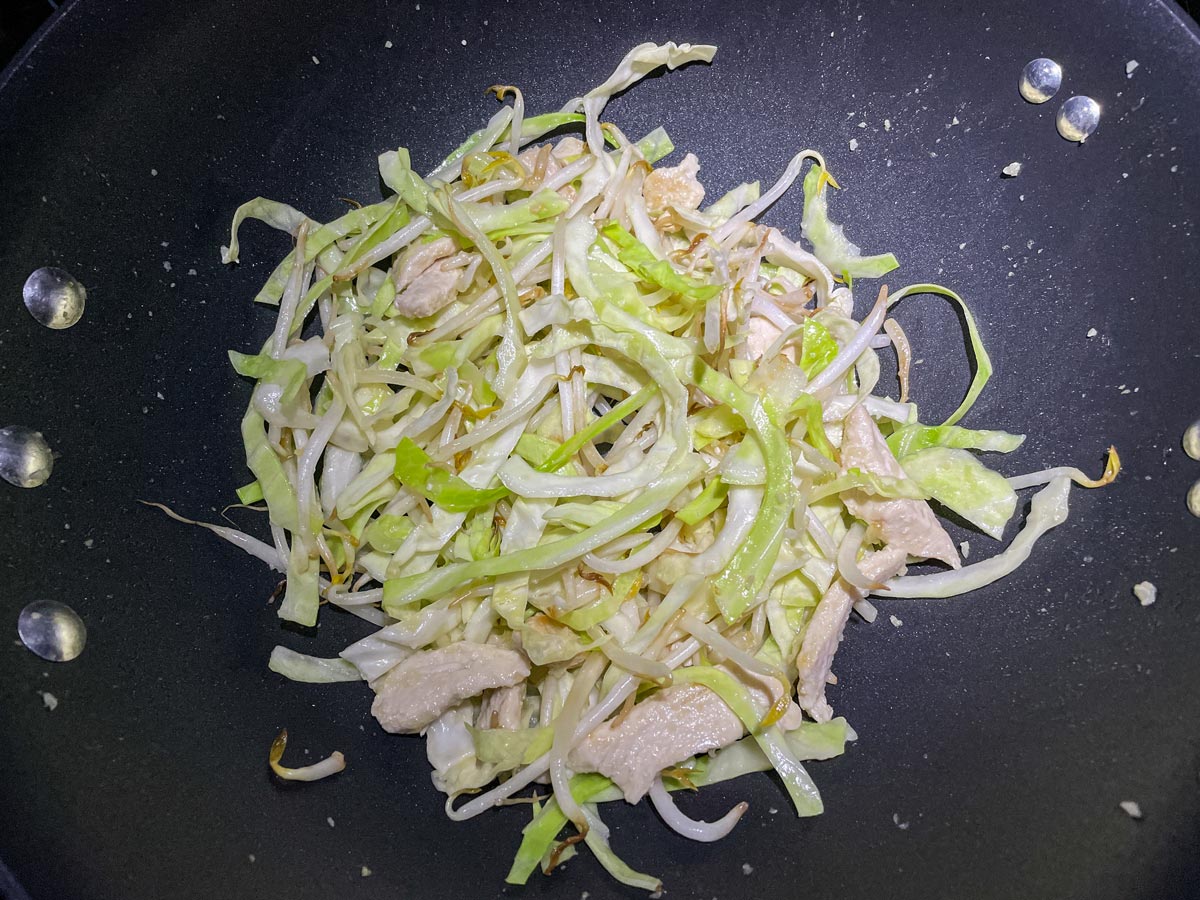
Add the tomato wedges and stir-fry for 30 to 60 seconds until they start to soften (Note: if using par-cooked noodles you can hold off on adding the tomatoes until the last step and add them with the omelet and scallions so they stay more intact).
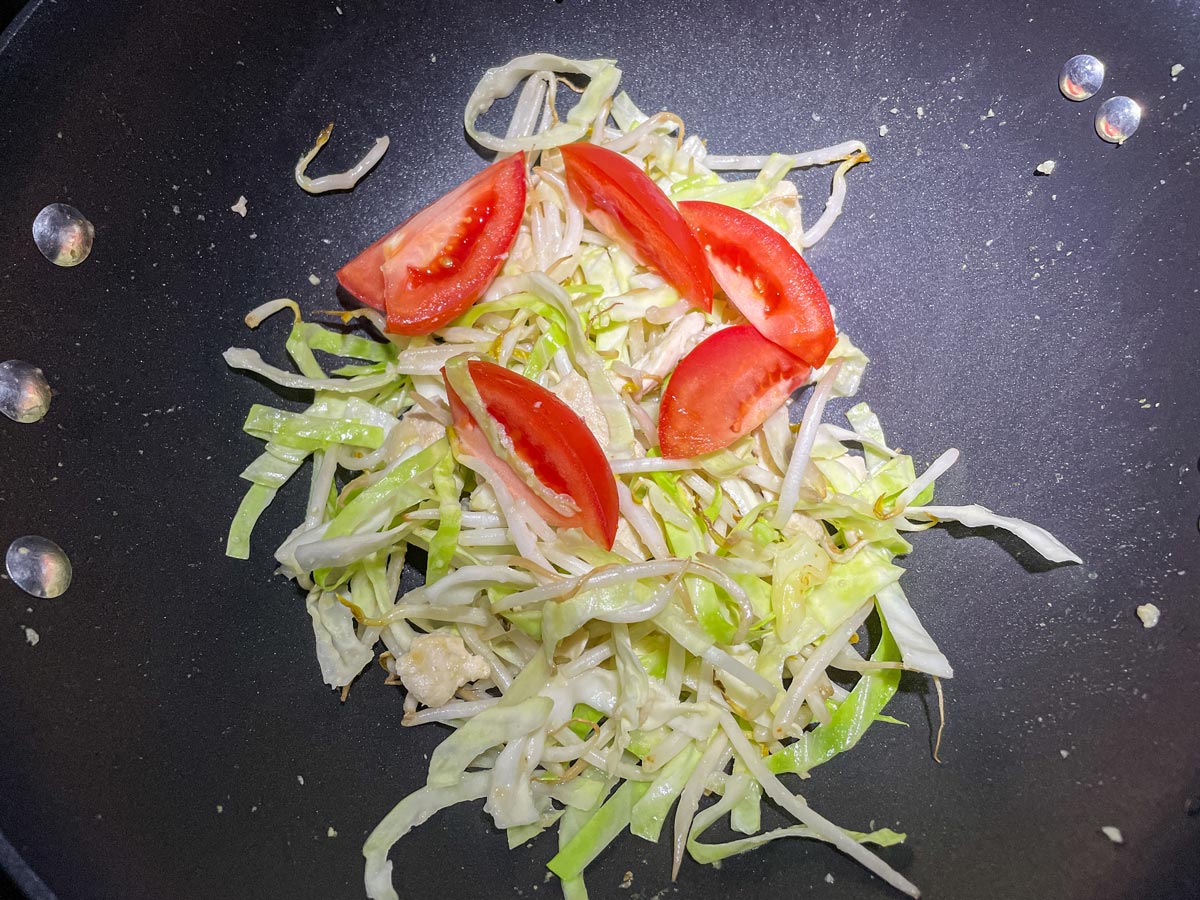
Add the noodles and the prepared sauce.

If you have boiled your noodles, stir-fry them for about 1 minute, but if your noodles are the par-cooked kind that don’t require boiling first, stir-fry for about 3 minutes so they can finish cooking now. You can add a splash of water or two if it seems really dry. This will help finish hydrating the noodles since the stir-fry sauce is on the thicker side.
Finally, add the chopped/sliced omelet, scallions, and tomatoes if you hadn’t added them earlier. Toss together until evenly coated, cooking for another minute so all the flavors absorb. Serve immediately.
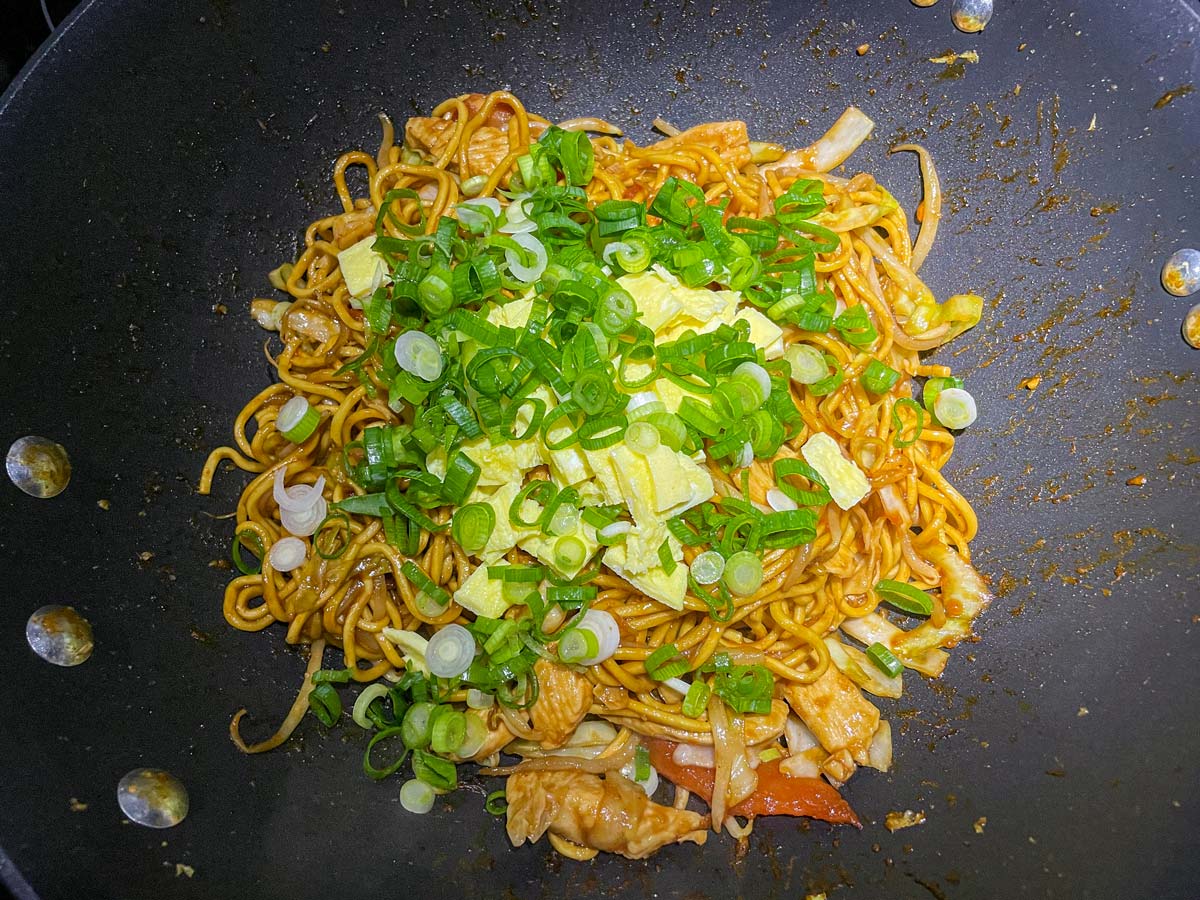
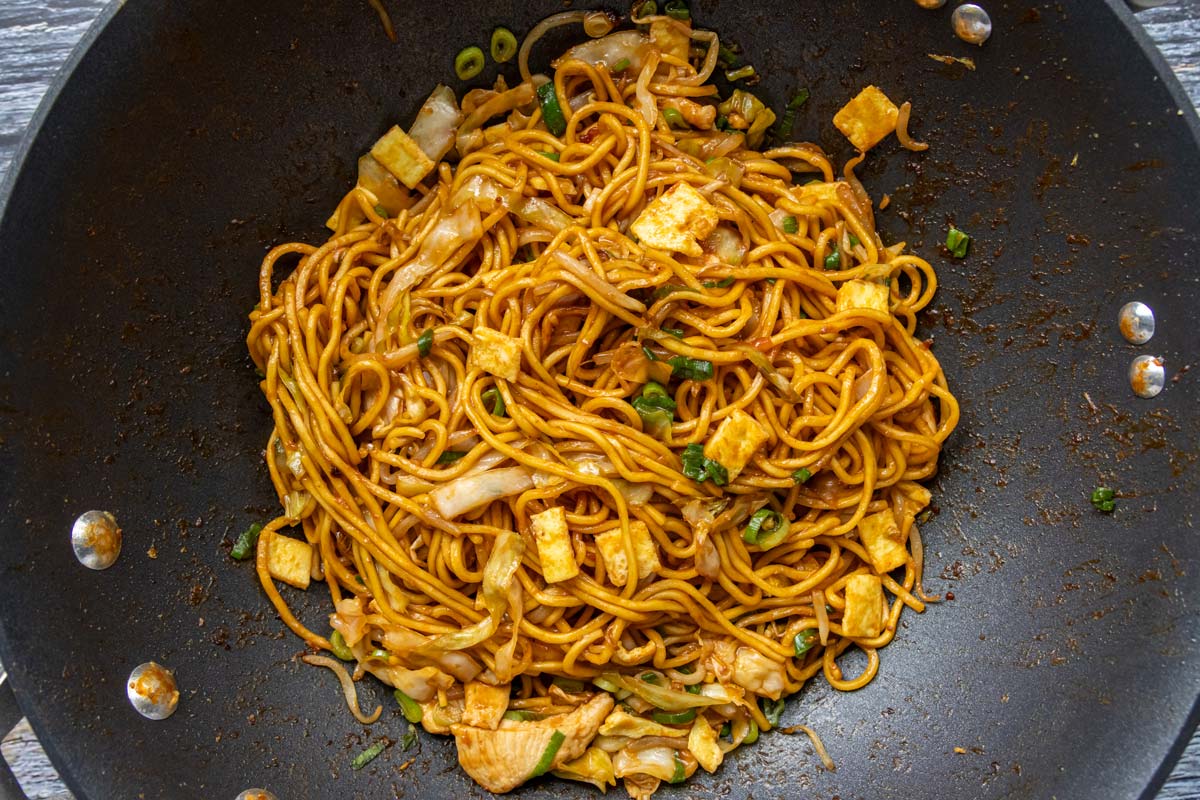
Please scroll to the bottom of the post for the full recipe (in a printable recipe card) including ingredient amounts and detailed instructions.

Expert tips and FAQ
Refrigerate leftover mie goreng for up to 3 days. You can reheat leftovers in the microwave or in a nonstick pan. Add a splash of water if needed to break them up a bit as you reheat them.
You can certainly customize this recipe to your preferences (or to whatever you have on hand). Here are some suggestions:
- Omit the chicken/shrimp and use a vegetarian stir-fry sauce instead of the oyster sauce to make a vegetarian version
- Replace the meat with cubed tofu
- Add more/other veggies such as bell peppers, mushrooms, or carrots
Make sure to properly heat your wok or skillet before you start cooking. The point of stir-fry cooking is to cook food quickly in a hot pan. Thus it also helps to have ingredients cut up into smaller pieces or strips to allow them to cook quickly and evenly.
While both popular Indonesian dishes feature kecap manis (Indonesian sweet soy sauce), the word "nasi" means rice while "mie" means noodles. Therefore, nasi goreng means "fried rice" and mie goreng means "fried noodles."
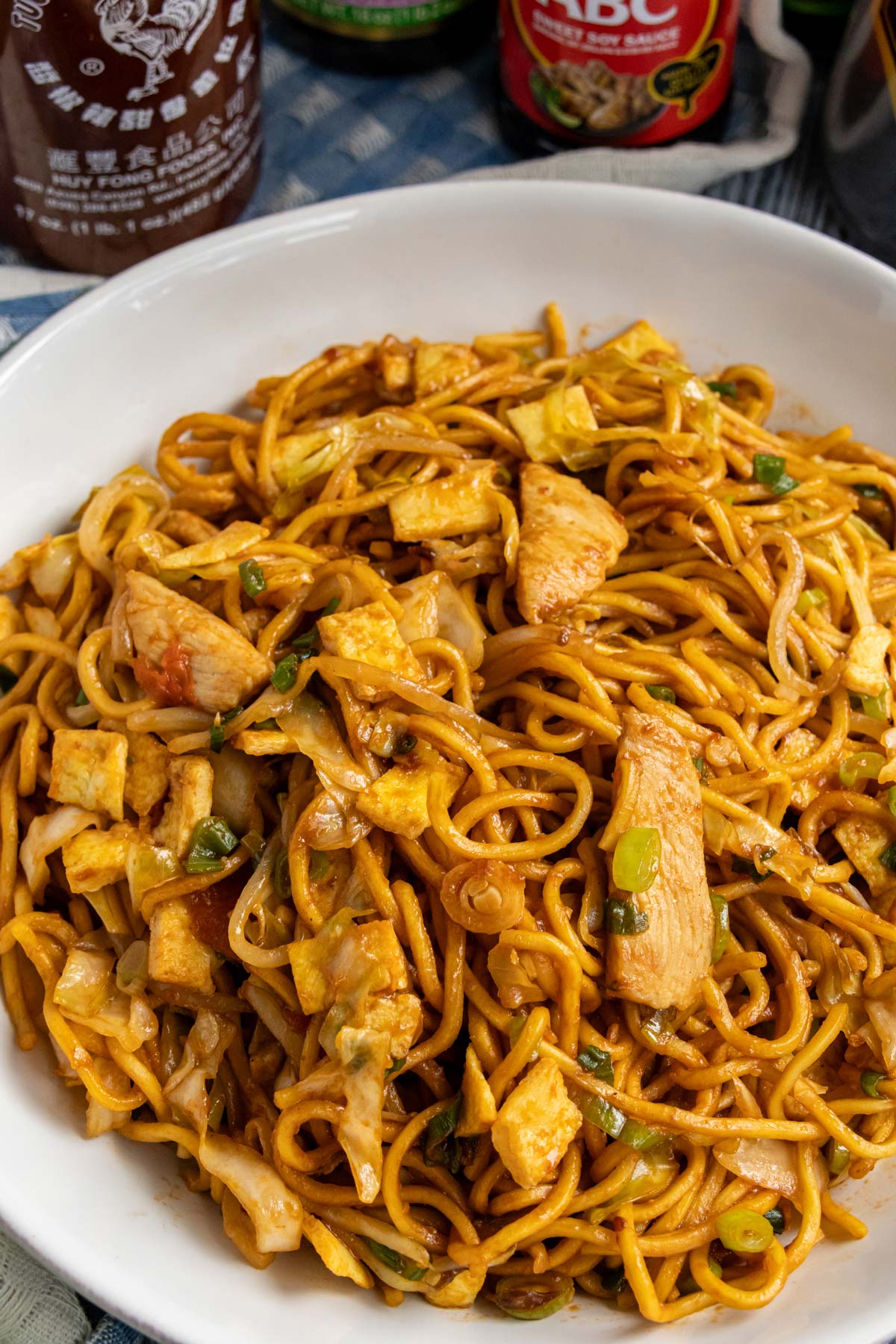
Other recipes you may like
- Nasi Goreng (Indonesian Fried Rice)
- Garlic Noodles
- Yaki Udon (Japanese Stir-Fried Udon Noodles)
- Ram-Don from Parasite (Jjapaguri with Steak)
- Japchae (Korean Sweet Potato Noodles with Meat and Vegetables)
- Singapore Noodles (Singapore Mei Fun)
- Pork Lo Mein
- Ants Climbing a Tree (Ma Yi Shang Shu)
- Authentic Pad Thai with Shrimp
Tried this recipe? Please leave a star ⭐️⭐️⭐️⭐️⭐️ rating in the recipe card below and/or a review in the comments section further down the page. You can also follow me on social media on Facebook, Instagram, and Pinterest!

Mie Goreng (Indonesian Stir-Fried Noodles)
Ingredients
Mie Goreng Sauce:
- 2 tablespoons kecap manis (sweet soy sauce)
- 1 tablespoon light (regular) soy sauce
- 2 tablespoons ketchup
- 1 tablespoon oyster sauce
- 2 teaspoons toasted sesame oil
- 1 teaspoon sriracha or sambal oelek or more if desired for more spice
Stir-Fried Noodles:
- 6 ounces (170 grams) dried Chinese egg noodles OR 10 ounces (285 grams) fresh/par-cooked Chinese egg noodles (any yellow/wheat noodles can work, but I used fresh/par-cooked chow mein aka Hong Kong-style stir-fry noodles)
- 1 tablespoon vegetable oil
- 1 large egg beaten
- 4 ounces (113 grams) thinly sliced raw chicken breast OR peeled and deveined shrimp
- 3 cloves garlic minced or crushed
- 1 cup packed (85 grams) shredded/thinly sliced cabbage or chopped bok choy
- 1 cup packed (85 grams) bean sprouts
- 1 roma tomato cut into 6 wedges
- 2 scallions chopped
Instructions
- Whisk together the sauce ingredients in a bowl and set aside.
- If using dry noodles or fresh noodles that require cooking, boil the noodles according to package directions, drain, rinse with cold water, and set aside. If using fresh/par-cooked noodles (check the packaging for cooking instructions), you don’t need to boil them in advance.
- While the noodles are boiling, heat half the oil in a wok or large (preferably nonstick) skillet or pan over medium-high heat. Add the beaten egg, tilting the pan slightly so it spreads out evenly. Cook the omelet for about 1 to 2 minutes and then flip it over and finish cooking the other side for a few more seconds until it’s cooked through (it’s ok if it breaks up, you’re going to chop it anyway). Remove from the pan to a cutting board and cut it into strips or dice it up.
- Add the remaining oil to the pan over high heat and add the chicken or shrimp, stir-frying for 1 to 2 minutes until mostly cooked through.
- Add the garlic, and stir-fry for another 30 to 60 seconds or so until fragrant. Toss in the cabbage and bean sprouts and cook for about 1 minute until they begin to wilt.
- Add the tomato wedges and stir-fry for 30 to 60 seconds until they start to soften (Note: if using par-cooked noodles you can hold off on adding the tomatoes until the last step and add them with the omelet and scallions so they stay more intact).
- Add the noodles and the prepared sauce. If you have boiled your noodles, stir-fry them for about 1 minute, but if your noodles are the par-cooked kind that don’t require boiling, stir-fry for about 3 minutes so they can finish cooking. You can add a splash of water or two if it seems really dry. This will help finish hydrating the noodles since the stir-fry sauce is on the thicker side.
- Finally, add the chopped/sliced omelet, scallions, and tomatoes if you hadn’t added them earlier. Toss together until evenly coated, cooking for another minute so all the flavors absorb. Serve immediately.
Notes
- Yellow Chinese egg noodles (such as chow mein noodles) are perfect for making mie goreng. You can use dried, fresh, or par-cooked Chinese egg noodles. Use about 10 ounces fresh/par-cooked in place of the 6 ounces dried. The par-cooked chow mein noodles I used are from Twin Marquis and can be added right to the stir-fry without boiling first. Always follow package directions to determine how to prep the noodles before stir-frying them, as methods will vary depending on the noodle. You could also use lo mein noodles (which are a bit thicker than chow mein noodles) or instant ramen noodles (about 3 packages of the noodles only without the seasoning packet). In a pinch, you could use spaghetti though it’s not really the best or most authentic substitute.
- Mie goreng isn’t mie goreng without kecap manis, or Indonesian sweet soy sauce. If you can’t find kecap manis to purchase it, you can make a variation yourself for this recipe. To do so combine three parts honey, maple syrup, or brown sugar with one part soy sauce.
- Although a lot of recipes don’t feature fresh tomatoes, my favorite mie goreng from a local restaurant includes tomatoes. I love the freshness and juiciness that the tomatoes contribute to this dish. If you add them midway through cooking they will soften and get juicy. Alternatively, add them closer to the end to retain their structure.
- You can certainly customize this recipe to your preferences (or to whatever you have on hand). Here are some suggestions:
- Omit the chicken/shrimp and use a vegetarian stir-fry sauce instead of the oyster sauce to make a vegetarian version
-
- Add more/other veggies such as bell peppers, mushrooms, or carrots
Nutrition
*All nutritional information is based on third-party calculations and should be considered estimates. Actual nutritional content will vary with brands used, measuring methods, portion sizes and more.*





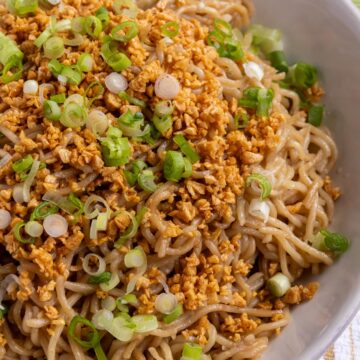
Comments
No Comments